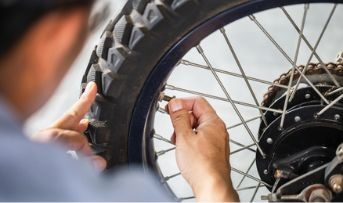General Insurance Blogs, Articles & Updates by - Magma HDI
Have us call you
- RENEW YOUR POLICY
- BUY NEW POLICY

Hand care tips for guitar aspirants to avoid injuries
Indulging in leisurely activities is an overlooked aspect of today's hectic lifestyles. With building pressures of being competent and work stress while handling societal expectations, it is essential to explore and identify areas of interest outside conventional academics, careers, etc. With the early onset of mental struggles with issues like depression and burnout, research has shown that engaging in at least one activity outside your regular schedule that allows you to enjoy your personal space is beneficial.
Learning instruments is one of the most popular activities taken up as a hobby. Learning to play the guitar is the most popular activity on many people's to-do lists. It is a relatively inexpensive hobby that can be learnt without an expert's guidance and does not require years of practice to reach the beginner's level of playing. However, there is always a risk of injury, considering the small fretboard, metal strings and fast wrist movements that need to be mastered.
Multiple factors come into play relating to your posture, wrist placement, plucking, and supporting hand placement that may result in injuries if not done correctly. Here are some tips to prevent injuries while playing the guitar.
1. Long durations of playing the guitar without adequate breaks:
Over practice causes more significant harm than good. While it may seem exciting to display your determination to learn the guitar by playing continuously without taking breaks, it is best not to do so.
There is no fixed duration that you should practise and then take a break after, but it is best to limit a practice session to 30-45 minutes and then take a 10-minute break. It also helps prevent neck or back injuries from sitting in the same position for long durations.
2. No warmup:
It is common to be excited and skip the fundamentals to learn advanced techniques. No matter what level of expertise, it is necessary to warm up before each playing session. This involves regular stretching and practising finger exercises on the fretboard. Multiple online resources can help prevent discomfort and increase your fingers' agility and precision while shifting chords and fingerpicking.
3. Excessive pressure:
Often seen in the case of beginner acoustic guitar players, it may seem challenging to produce sound on metal strings. It is natural to use excessive pressure on the strings in such a case as you try to learn better. However, as you practise, you must find the ideal amount of force, just enough to produce sound.
Excessive pressure applied during regular playing damages the fretboard and may cause discomfort to your fingers. It may even lead to the tearing of the fingertips' skin. Understand that ideal pressure results in the formation of calluses, not injuries.
4. Proper posture:
Getting the basics right is the most important thing to understanding any skill. Sitting upright will allow you to keep your spine, neck, arms and wrist strain-free. If you feel any specific pain repetitively as you practise, it is best to get the guidance of an expert or stand before a mirror to identify and correct the issue.
In case you feel irregular pains in your wrist, it is best to get it checked by a doctor and use supporting devices like a wrist brace upon professional recommendation. Icing the wrist and regularly massaging the area can help significantly reduce inflammation and pain. Since one cannot eliminate injuries, taking preventive care and buying comprehensive personal accident insurance India is necessary to cover the financial burden.
Click HERE to buy reliable personal accident insurance India.
Disclaimer: The information provided above is for illustrative purposes only. To get more details, please refer to policy wordings and prospectus before purchasing a policy.

Customisation tips to reflect your style through your bike
The rapidly growing two-wheeler market has adapted to the personalised needs of motorcyclists. Riders prefer to make a statement with their uniquely customised bikes that turn heads wherever they go. Once only considered modes of convenient private commute, bikes translate to much more in modern times.
If you wish to apply your style preferences to your bike, you can use several customisation options.
Caution: Check your 2 wheeler insurance policy
However, study your 2 wheeler insurance policy's fine prints to verify if it covers accidents post modifications. Generally, most 2 wheeler insurance providers reject claims raised for bikes that have been primarily modified. This is due to the enhanced risk of accidents from tampering with the manufacturer's original bike tunings.
Considering this general caution, read on to find out how you can customise your two-wheeler to suit your style better:
1. Rear-view mirrors
Rear-view or side mirrors are an integral part of the riding experience. They facilitate traffic visibility which helps make better judgements. These mirrors come in various shapes, sizes, colours, and styles to fit every rider's fancy while being extremely functional!
2. Handlebar
Although subtle, one of the first things that catch the viewer's eye when looking at a two-wheeler is its handlebar. Essential for maintaining posture and a comfortable grip, you can opt for different handlebars to alter the overall look of your bike. Choose between the wide bar of cruisers or narrow to straight bars that allow greater grip for adventurous riding.
3. Grips
If the overall feel of your handlebar is perfect and needs no change, but you wish to add a pop of colour to it, change the grips! Firmly glued on, you may have to force the existing grips off. You may approach a local mechanic for help to pry them off and get a new pair in a different colour, design, texture, or with additional features.
4. Fuel tank pad
A fuel tank pad is a cost controller and prevents the evaporation of your bike's fuel. Such a functional component set at the centre of the bike's chassis can add extra oomph to your daily ride. Choose among a vast range of colours and textures that prevent scratches to the gas tank due to scraping of metal accessories of your riding gear.
5. LED lights
Adding LED lights along the body frame in strategic positions or replacing your head and tail lights with LED variants will make you catch everyone's eye. LED strip lights are a quick fix for the same effect.
Listed above are some customised practices that global motorcyclists use to set their bikes apart from conventional designs we commonly see on roads. Wishing to incorporate personal style preferences across all your belongings is typical. However, when dealing with two-wheelers, it is essential to draw limits to prevent altering the original build and functionality. This helps preserve its efficiency in the long run.
Before making significant alterations relating to shifters, add-on storage racks, etc., one must consider their 2 wheeler insurance policy wordings to stay within its coverage scope. Irrespective of the scale of modifications, ensure that you purchase 2 wheeler insurance to protect yourself against accidents.
Click HERE to buy 2 wheeler insurance that fits your requirements.
Disclaimer: The information provided above is for illustrative purposes only. To get more details, please refer to policy wordings and prospectus before purchasing a policy.

Did you know that your bathing habits can impact your digestion
Our elders followed a healthy lifestyle and had a long lifespan, however, life expectancy has been going down in recent years. A big reason for this is the inability to follow a healthy lifestyle due to our busy schedules and poor dietary habits. We are more prone to falling ill and catching several seasonal and life-threatening diseases. The majority of health conditions rely on your eating habits and digestion. Did you know that even your bathing habits can impact your digestion? This has been certified by both Ayurveda and modern science.
Let us see how our bathing habits impact our digestion.
Say no to shower immediately after a meal.
Whenever we eat a meal, our body rushes blood to the digestive system. This helps it in the digestion process. As a result, heat is generated inside the body to break down the food.
Ayurveda’s point of view:
According to Ayurveda, this heat is the fire element inside us. Whenever we eat something, it gets activated and helps in the digestion process. Taking a shower has a cooling effect on the body. It automatically lowers the body temperature. The fire element or the heat in the body cools down, and the blood flow also slows down. This directly impacts the digestive process, in turn, and slows it down considerably. Hence, taking a shower after a meal harms our digestive system.
Medical science’s point of view:
The same fact is corroborated by medical science but differently. It says that taking a shower right after a meal slows down the blood flow because of the cooling effect. Our body starts working harder to maintain a standard temperature to help in the digestion process. The blood that should help in the digestion process is diverted to other parts of the body. This results in the slowing of the digestive process.
It may also cause acidity and uneasiness, and you may feel a sense of nausea. Our bodies may start feeling dull and sluggish. You might have a comforting sleep after a shower, but it will be bad for your digestive system. A bath after a meal can increase your heart rate and may add to your discomfort when your stomach is full. Therefore, medical science also discourages a bath right after a meal.
Type of meal.
As mentioned above, bathing right after a meal is bad for our digestive system. However, how bad it varies with the type of food that we have. A meal high in protein or fat may result in bloating and slowing down our digestive process. Having lighter food such as fruits, salad or soup will have a lesser negative effect on our digestive system. Eat what suits your stomach the best while also taking care of your body’s nourishment.
Waiting time.
It is not that we cannot take a bath all day after having a heavy meal. We need to wait for some time after we have had a heavy meal so that the food gets time to digest. This waiting time may vary from person to person, but generally, a gap of 30 minutes is advisable for taking a bath after a meal.
It is best to take a bath early in the morning to feel fresh, relaxed and rejuvenated. If we cannot take a bath before breakfast, we should avoid taking it right after we have a meal due to the above-mentioned reasons.
Indigestion results in multiple problems, such as upset stomach, stomach pain, nausea, etc. Chronic indigestion can be a big problem and lead to other serious illnesses. Hence, we should invest in the best health insurance policy in India to protect ourselves and our families. A health insurance policy can be a saviour as treatment costs have skyrocketed in recent years in India. It will provide us security in times of illness and keep our savings intact.
Click HERE to buy the best health insurance policy in India.
Disclaimer: The information provided above is for illustrative purposes only. To get more details, please refer to policy wordings and prospectus before purchasing a policy.

Decoding the markings on your bike tyre’s sidewalls
Have you ever looked at your motorcycle's tyres and wondered what all the numbers and letters on the sidewall mean? Tyre sidewall markings can be confusing, but they contain essential information about your tyres to help you maintain and replace them correctly.
This blog will decode the markings on your bike tyre's sidewalls to help you better understand them. So, without further delay, let's get started.
1. Understanding tyre size markings
One crucial aspect of understanding the markings on your bike tyre's sidewall is to know how to read the size markings. The first set of numbers and letters is the size marking. It typically appears as a combination of numbers and letters, such as 120/70 R17. The number 120 refers to the tyre's width in millimetres, whereas 70 denotes the aspect ratio or profile of the tyre, representing the sidewall's height as a percentage of the width.
For instance, if the width is 120mm, the sidewall height would be 70% of 120mm, which equals 84mm. Lastly, the number 17 represents the wheel rim's diameter in inches. Choosing the correct tyre size for your motorcycle is crucial to prevent performance, handling, and tyre failure issues.
2. Tyre load index and speed rating
The load index and speed rating are necessary markings on your bike tyre's sidewall. The load index indicates the maximum weight the tyre can carry, while the speed rating indicates the top speed that the tyre can handle.
A number on the sidewall represents the load index. This number ranges from 1 to 279 and corresponds to a specific weight limit for the tyre. You can find a load index chart online to determine the weight limit of your tyre.
The speed rating is represented by a letter on the sidewall. This letter ranges from A to Z and corresponds to a specific speed limit for the tyre. Again, you can find a speed rating chart online to determine the maximum speed limit of your tyre. You must select a tyre with the appropriate load index and speed rating for your motorcycle.
3. Tyre manufacturing date code
Every tyre has a manufacturing date code on its sidewall. The code consists of four digits, the first two representing the week and the last two representing the year of manufacture. For example, if the code reads "1719," the tyre was produced in the 17th week of 2019.
It is important to note that tyres have a lifespan of about six years, even if they appear to be in good shape. They should be replaced six years after their initial manufacturing date, regardless of their wear and tear. Therefore, checking the manufacturing date code is critical in determining the tyre's age and deciding when to replace it.
4. Importance of proper tyre maintenance
Proper tyre maintenance is essential for safe and efficient riding. Tyres that are underinflated, overinflated, or worn out can affect your bike's handling and performance, increasing the risk of accidents. Regularly checking tyre pressure, tread depth, and overall condition can ensure that your bike's tyres are in good shape and provide optimal performance. Additionally, tyre rotation and alignment can help distribute wear evenly, extending its lifespan.
Decoding the markings on your bike tyre's sidewalls is critical for ensuring the safety and longevity of your bike. Proper tyre maintenance is also essential for safe and efficient riding. The safety of a bike is incomplete without bike insurance. Robust bike insurance can provide financial protection in case of accidents or damages. As a responsible rider, you must know these factors and take the necessary precautions to keep your bike in shape.
Comprehensive bike insurance covers not only damages to your bike but also liabilities arising from accidents involving third parties. It is important to note that bike insurance policies often have specific coverage for tyre damages or replacements, which can help offset the cost of replacing worn-out or damaged tyres.
Click HERE to learn more about the benefits of purchasing bike insurance.
Disclaimer: The information provided above is for illustrative purposes only. To get more details, please refer to policy wordings and prospectus before purchasing a policy.


